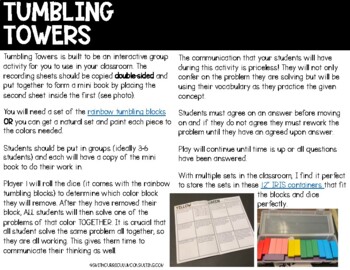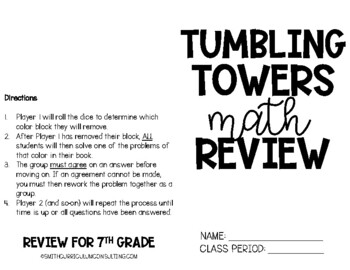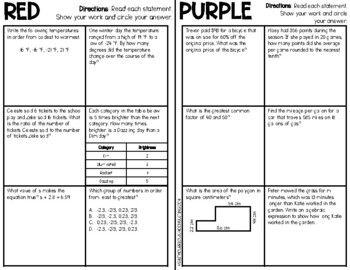Tumbling Towers 6th Grade Math Skills End of Year Review Game
- PDF
What educators are saying
Description
Are you ready to review Sixth Grade Math Concepts in a highly engaging and fun way? Your students will be begging to play this game over and over as they try not to tip over their Tumbling Blocks while reviewing concepts for Sixth Grade Math!
Tumbling Towers is an interactive learning activity meant for a small group where students will roll a dice to determine what color block they will pull from the stack. Once they have pulled the block from the stack they will then turn to that section in their mini book and choose a problem. ALL students in the group will work on that problem.
Once students have answered the problem they will then discuss and agree upon the answer before moving on to the next player. Play will continue until time is called, the blocks fall or all questions have been answered.
The Sixth Grade Math Review is perfect to use for Back to School for Seventh Graders or even End of School Review for Sixth Graders.
All activities are aligned to 6th Grade Common Core (CCSS), 6th Grade Texas Essential Knowledge and Skills (TEKS), and 6th Oklahoma Academic Standards (OAS) and are meant to be able to be used in any 6th-grade classroom.
Looking for other activities to review 6th Grade Concepts?
- 6th Grade Solve and Snips Bundle
- 6th Grade Math Workshop Full Year Bundle
- 6th Grade Spin to Win
- 6th Grade Practice and Homework Sheets (Print and Digital)
***********
Personal Copyright: The purchase of this product allows you to use these activities in your personal classroom for your students. You may continue to use them each year but you may not share the activities with other teachers unless additional licenses are purchased. Please contact me via email for additional licenses. Site and District Licenses are also available.
4mulaFun™, Flippables®, Solve and Snip®, and Interactivities® are trademarks of Smith Curriculum and Consulting (formerly FormulaFun Inc. dba 4mulaFun™), and are registered in the United States and abroad. The trademarks and names of other companies and products mentioned herein are the property of their respective owners. Copyright ©Smith Curriculum and Consulting All rights reserved.
DISCLAIMER: With the purchase of this file you understand that this file is not editable in any way. You will not be able to manipulate the lessons and/or activities inside to change numbers and/or words.





